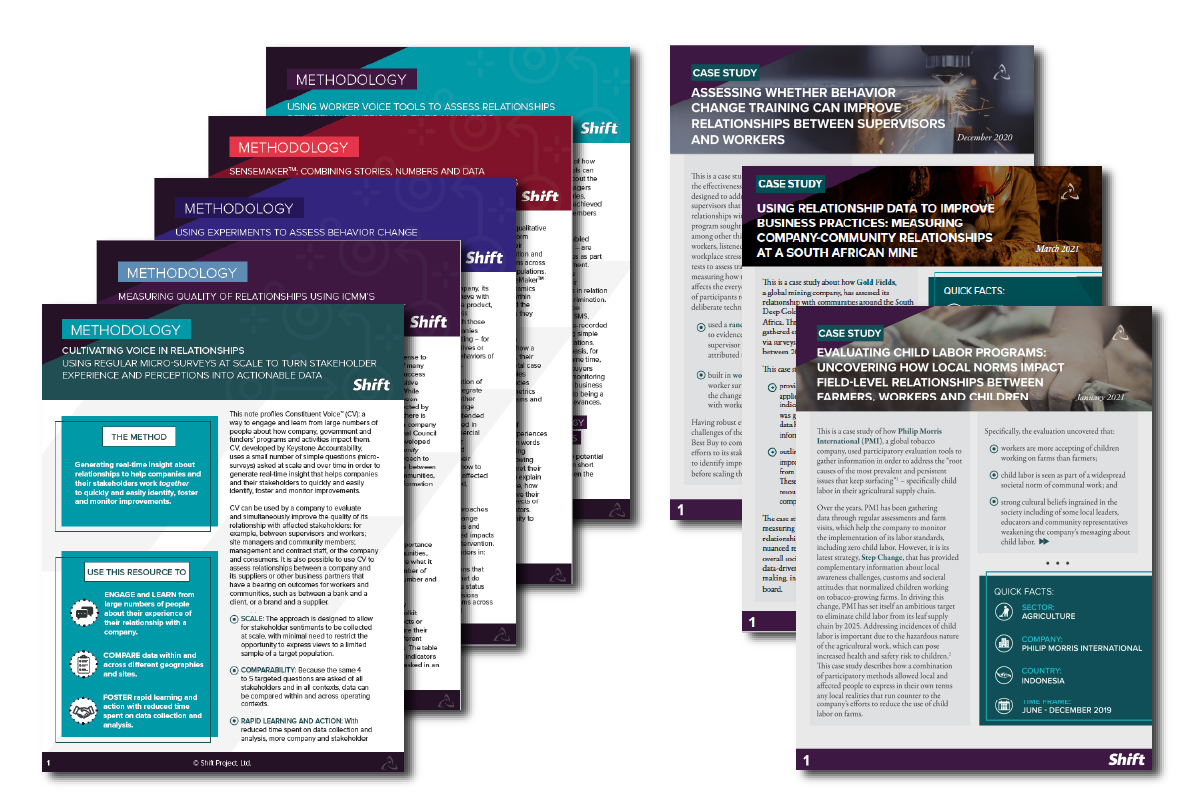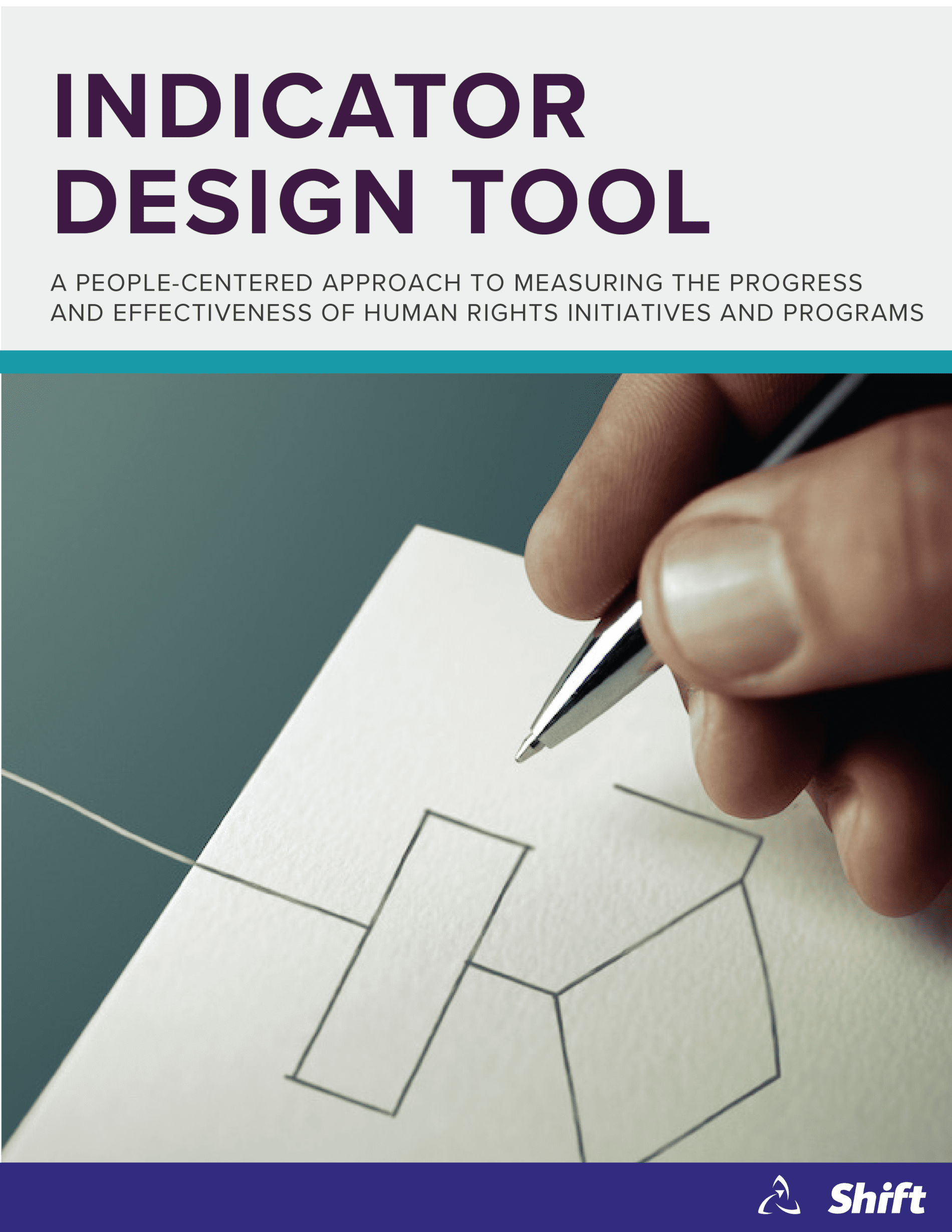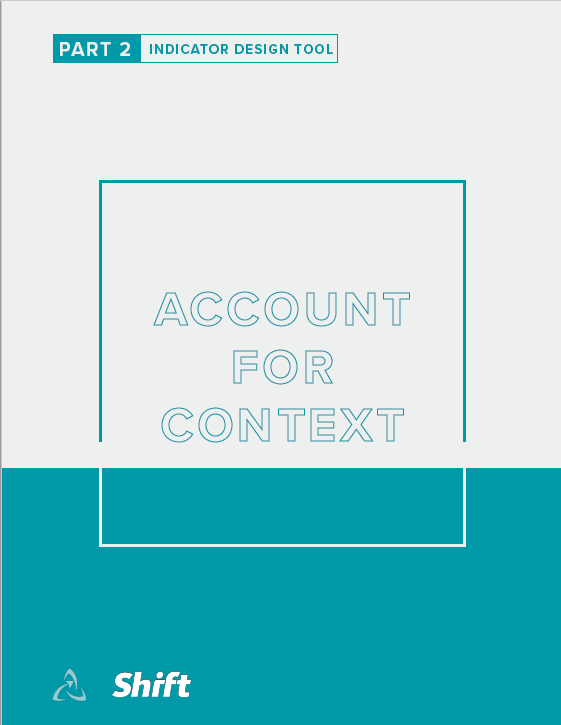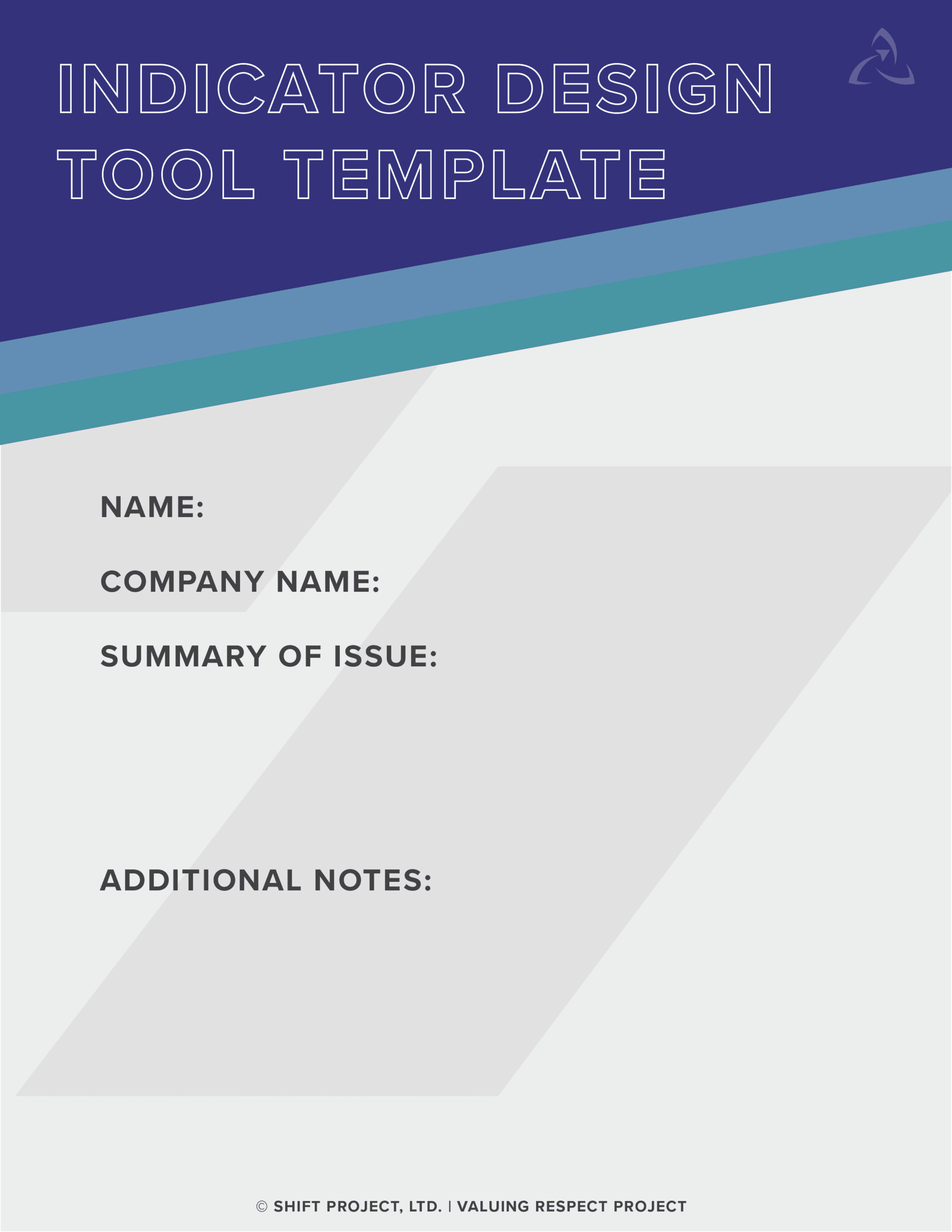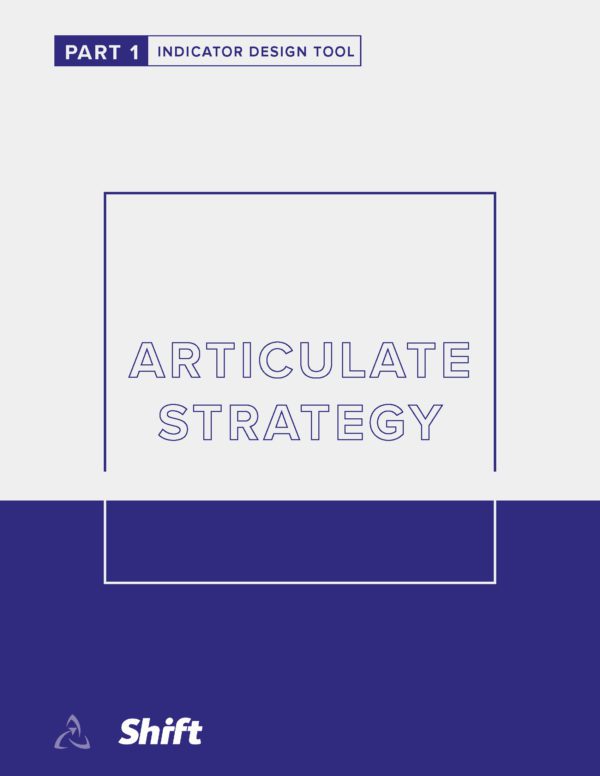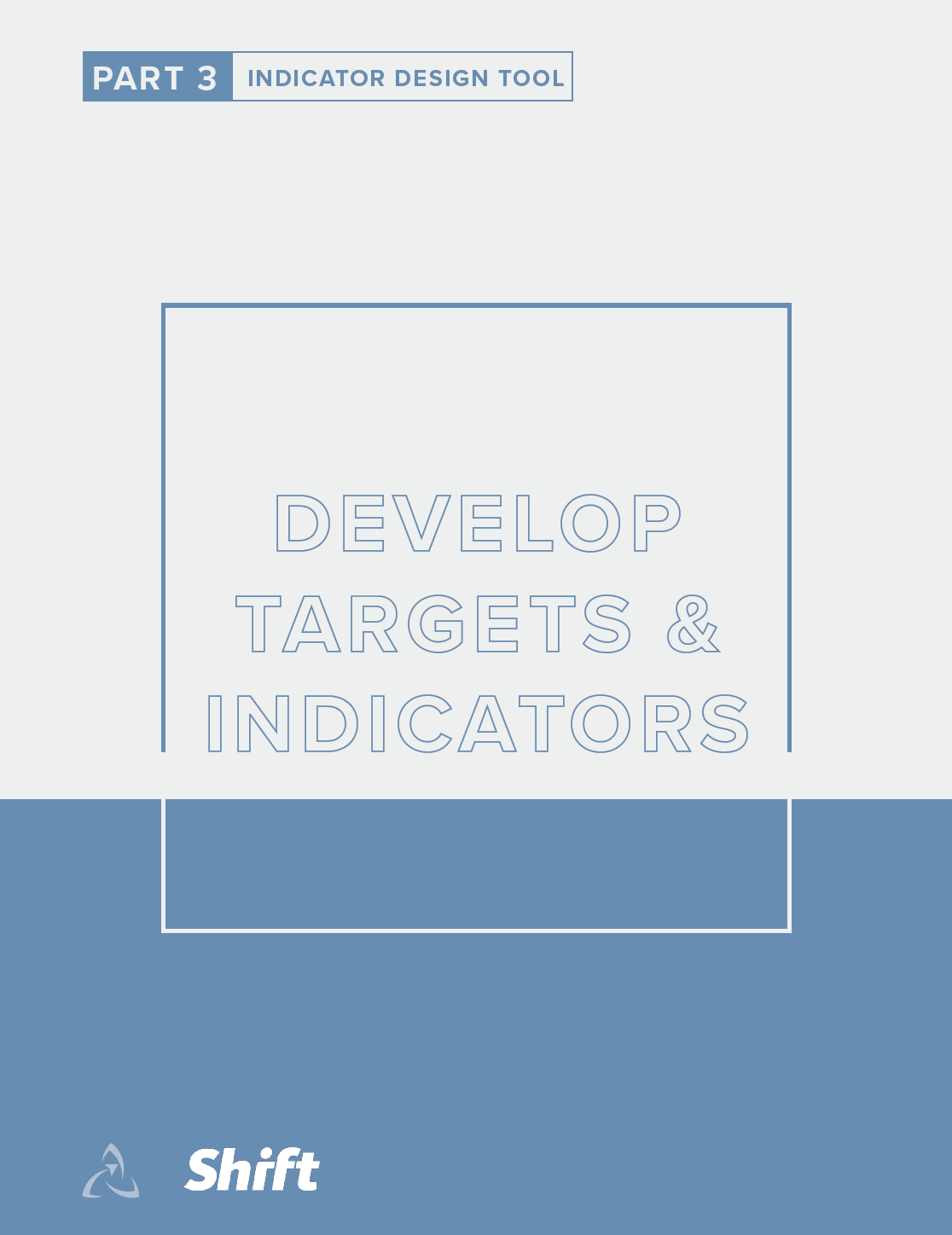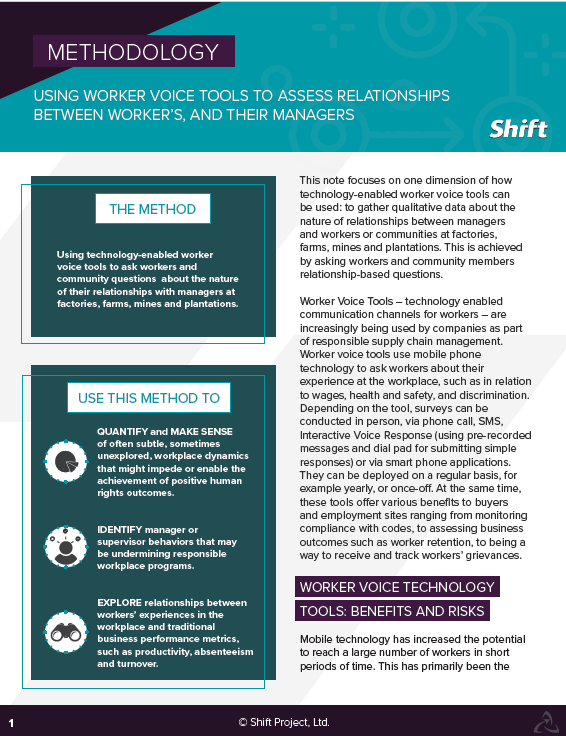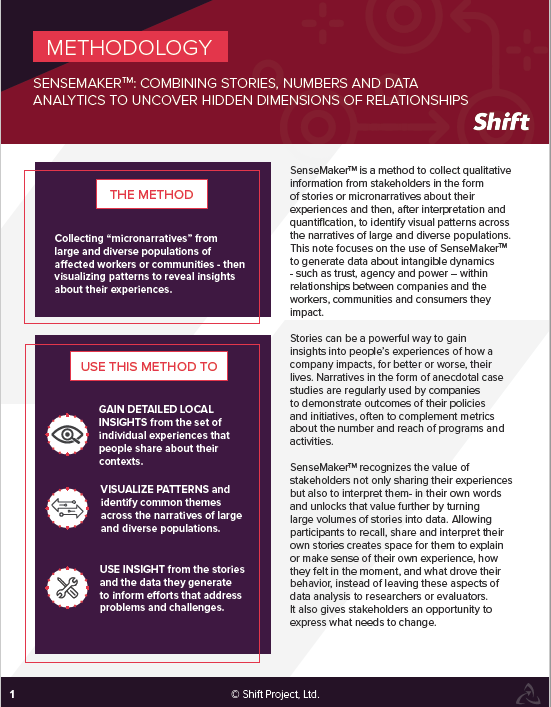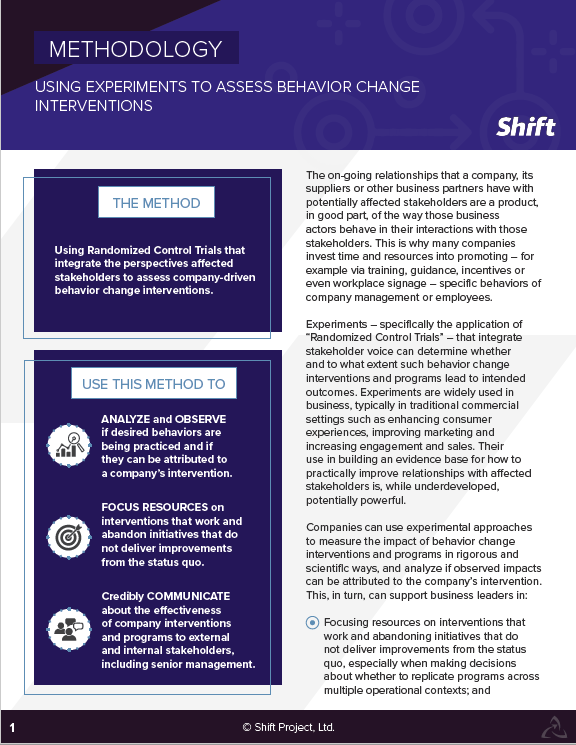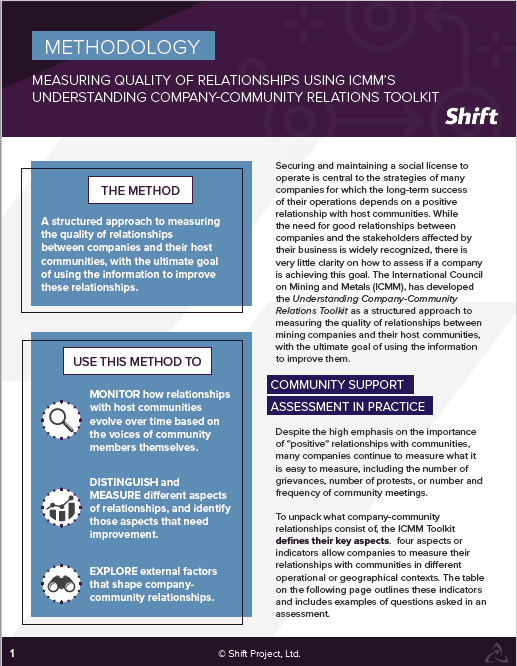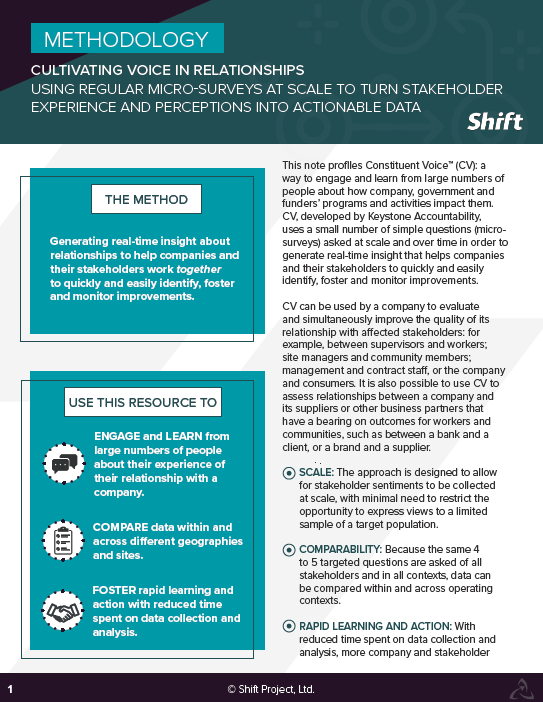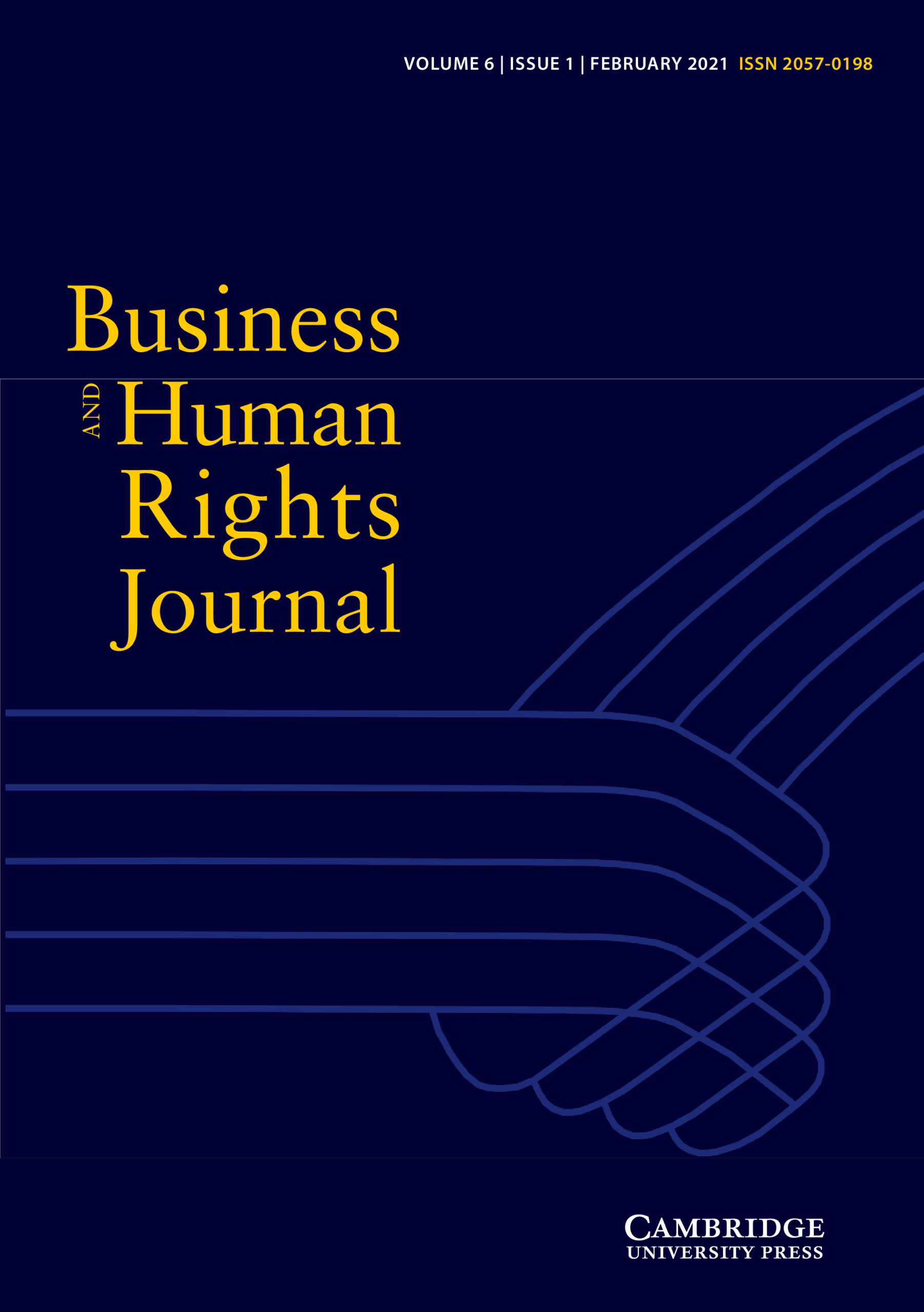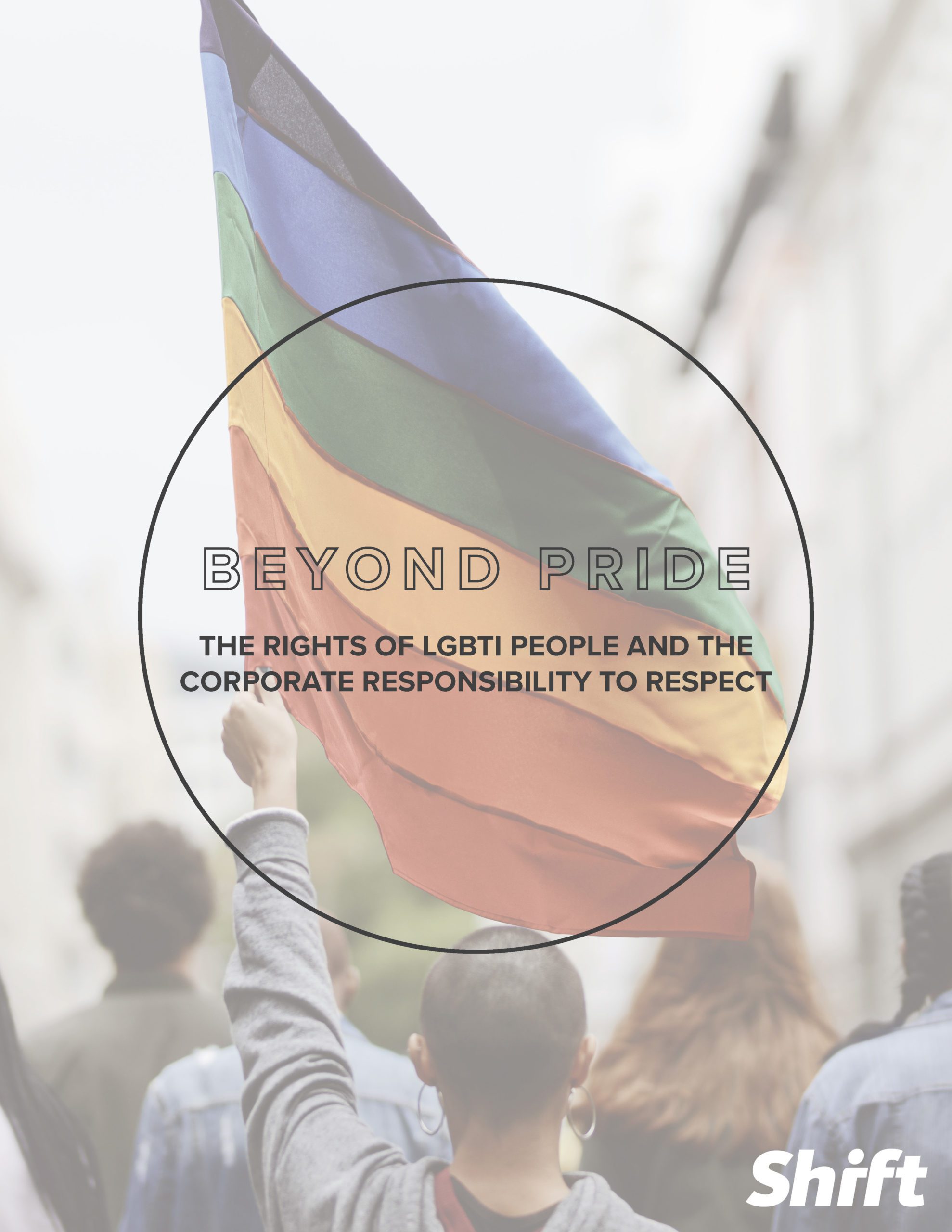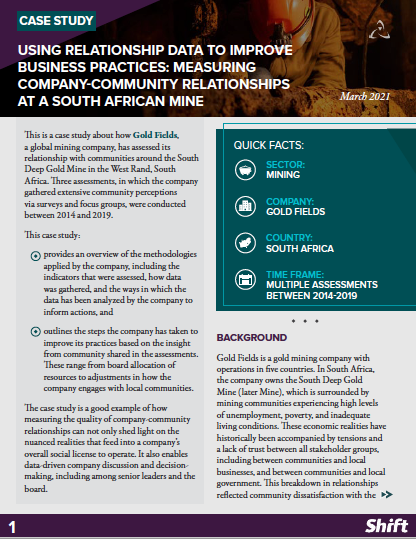Archives: Resources
Downloadables
Using Worker Voice Tools to Assess Relationships Between Workers and their Managers
This note focuses on one dimension of how technology-enabled worker voice tools can be used: to gather qualitative data about the nature of relationships between managers and workers or communities at factories, farms, mines and plantations. This is achieved by asking workers and community members relationship-based questions.
Use this method to:
- Quantify and make sense of often subtle, sometimes unexplored, worker dynamics that might impede or enable the achievement of positive human rights outcomes.
- Identify manager or supervisor behaviors that may be undermining responsible workplace programs.
- Explore relationships between workers’ experiences in the workplace and traditional business performance metrics, such as productivity, absenteeism and turnover.
Sensemaker: Combining Stories, Numbers and Data Analytics to Uncover Hidden Dimensions of Relationships
SenseMaker is a method to collect qualitative information from stakeholders in the form of stories or micro narratives about their experiences and then, after interpretation and quantification, to identify visual patterns across the narratives of large and diverse populations.
This note focuses on the use of SenseMaker to generate data about intangible dynamics –such as trust, agency and power – within relationships between companies and the workers, communities and consumers they impact.
Use this method to:
- Gain detailed local insights from the set of individual experiences that people share about their contexts.
- Visualize patterns and identify common themes across the narratives of large and diverse populations.
- Use insight from the stories and the data they generate to inform efforts that address problems and challenges.
Using Experiments to Assess Behavior Change Interventions
The ongoing relationships that a company, its suppliers or other business partners have with potentially affected stakeholders are a product, in good part, of the way those business actors behave in their interactions. This is why many companies invest time and resources in promoting – for example via training, guidance, incentives or even workplace signage – specific behaviors of company management or employees.
Experiments – specifically the application of Randomized Control Trials (RCTs) – that integrate stakeholder voice can determine whether and to what extent such behavior change interventions and programs lead to intended outcomes.
Use this method to:
- Analyze and observe if desired behaviors are being practiced and if they can be attributed to a company’s intervention.
- Focus resources on interventions that work and abandon initiatives that do not deliver improvements from the status quo.
Measuring Quality of Relationships: Using ICMM’s “Understanding Company-Community Relations” Toolkit
Securing and maintaining a social license to operate is central to the strategies of many companies for which the long-term success of their operations depends on a positive relationship with host communities. While the need for good relationships between companies and their host communities is widely recognized, there is very little clarity on how to assess if a company is achieving this goal. The International Council on Mining and Metals (ICMM), has developed the Understanding Company-Community Relations Toolkit as a structured approach to measuring the quality of relationships between mining companies and their host communities, with the ultimate goal of using the information to improve them.
Use this tool to:
- Monitor how relationships with host communities evolve over time based on the voices of community members themselves.
- Distinguish and measure different aspects of relationships and identify those aspects that need improvement.
- Explore external factors that shape company-community relationships.
Cultivating Voice in Relationships: Using Regular Micro-surveys at Scale to turn Stakeholder Experience and Perceptions into Actionable Data
This note profiles Constituent Voice (CV): a way to engage and learn from large numbers of people about how company, government and funders’ programs and activities impact them. CV, developed by Keystone Accountability uses a small number of simple questions (micro-surveys) asked at scale and over time in order to generate real-time insight that helps companies and their stakeholders to quickly and easily identify, foster and monitor improvements.
Use this resource to learn about a methodology that can help you:
- Engage and learn from large numbers of people about how they experience their relationship with a company.
- Compare data within and across different geographies and sites.
- Foster rapid learning and action with reduced time spent on data collection and analysis.
Ten Years After: From UN Guiding Principles To Multi-Fiduciary Obligations
Ten years on from the UN Guiding Principles, the soft law of human rights due diligence has helped provide a path beyond shareholder primacy towards stakeholder governance. This is now influencing hard law, particularly in Europe. In this paper, Shift’s Chair, Professor John Ruggie, and our two co-founders, Caroline Rees and Rachel Davis explain the journey.
The paper is divided into five parts. The first recaps the current debate regarding the purpose of the corporation, which centers on whether and how stakeholder governance should and could supersede shareholder primacy. The second provides a brief backstory on shareholder primacy versus stakeholder governance. The third introduces the elements of HRDD and demonstrates that even in its soft law form it is bringing stakeholder concerns and corporate practice into closer alignment. Section IV describes how this experience with soft law is informing national and supranational legal requirements in a growing number of jurisdictions, with knock-on effects for corporate governance. The conclusion endeavors to draw some lessons from how, a mere decade after UN endorsement of the Guiding Principles, they have turned the idea that companies are responsible for preventing and addressing adverse impacts of their business on people’s basic dignity and equality into a mainstream proposition with significant implications for corporate governance while acknowledging that large gaps remain in the BHR space.
Beyond Pride: The Rights of LGBTI People and the Corporate Responsibility to Respect
In every region of the world lesbian, gay, bisexual, transgender and intersex (LGBTI) people face some degree of violence, persecution or discrimination.
From what is said around a family dinner table to who gets to compete in a sports contest; from who is welcome in a bathroom to who is sentenced in a court room; to forced sterilization and harmful medical procedures; and from who gets an apartment, job offer or promotion to who gets imprisoned, flogged or sentenced to death. The contexts for such violence and discrimination are as varied as the people in the LGBTI acronym, and pose a wide range of human rights risks for companies.
Businesses have a responsibility – under the UN Guiding Principles on Business and Human Rights (UNGPs) – to understand and address how their actions, decisions, omissions and business relationships can lead to negative impacts on people. In the case of LGBTI people, that means considering how they could be adding to the risk that they already face on the basis of their sexual orientation, gender identity or expression, or sex characteristics (SOGIESC).
Use this resource to:
- Learn how business activities and relationships can exacerbate risks faced by LGBTI people.
- Understand why risk can vary depending on geographical and cultural context, and what that means for global businesses.
- Explore how companies can understand the particular vulnerabilities experienced by LGBTI people to better identify risks and prioritize action.
- Review what companies are doing to address risks to the rights of LGBTI people, and where the gaps are in existing practice.
- Consider meaningful ways in which companies can engage with LGBTI stakeholders and use their leverage with peers, partners, suppliers, governments and others
Using Relationship Data to Improve Business Practices: Measuring Company-Community Relationships at a South African Mine
This is a case study about how Gold Fields, a global mining company, has assessed its relationship with communities around the South Deep Gold Mine in the West Rand, South Africa. Three assessments, in which the company gathered extensive community perceptions via surveys and focus groups, were conducted between 2014 and 2019.
This case study:
- provides an overview of the methodologies applied by the company, including the indicators that were assessed, how data was gathered, and the ways in which the data has been analyzed by the company to inform actions; and
- outlines the steps the company has taken to improve its practices based on the insights from the community shared in the assessments. These range from board allocation of resources to adjustments in how the company engages with local communities.
The case study is a good example of how measuring the quality of company-community relationships can not only shed light on the nuanced realities that feed into a company’s overall social license to operate. It also enables data-driven company discussion and decision-making, including among senior leaders and the board.
“At a very early stage of the work, we realized that we needed to listen and understand how our communities really felt about us. Initially, this was an uncomfortable process as we learned about the differences between how we thought the communities felt about our presence and their experiences on the ground. Given strong board-level support and visibility on this new way of engagement, our teams on the ground felt that it was critical to measure the strength of our relationships. Even though there were no readily available tools at the time we got started – a crude windsock would be better than nothing. Much has evolved since those early days with the relationship tools now more developed and providing insights for our long journey ahead in building trust with a key stakeholder. As the saying goes, if it is important, you need to manage it – what you can measure, you can manage.”
Naseem Chohan, EVP Sustainable Development and South Deep Gold Mine board member

 Business Model Red Flags
Business Model Red Flags  Tool for Indicator Design
Tool for Indicator Design 